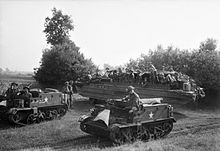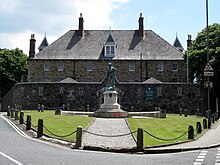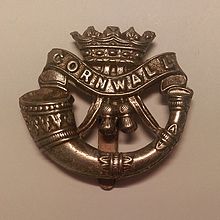|
Duke of Cornwall's Light Infantry
 The Duke of Cornwall's Light Infantry (DCLI) was a light infantry regiment of the British Army in existence from 1881 to 1959. The regiment was created on 1 July 1881 as part of the Childers Reforms, by the merger of the 32nd (Cornwall Light Infantry) Regiment of Foot and the 46th (South Devonshire) Regiment of Foot. The DCLI also incorporated the militia and rifle volunteers of Cornwall. In 1959 the regiment merged with the Somerset Light Infantry (Prince Albert's) to form the Somerset and Cornwall Light Infantry. However, this was amalgamated with the Durham Light Infantry, the King's Shropshire Light Infantry and the King's Own Yorkshire Light Infantry to form The Light Infantry which was also merged, in 2007, with the Devonshire and Dorset Regiment, the Royal Gloucestershire, Berkshire and Wiltshire Regiment and the Royal Green Jackets to form The Rifles, which continues the lineage of the DCLI. HistoryThe regiment was created on 1 July 1881 as part of the Childers Reforms, by the merger of the 32nd (Cornwall Light Infantry) Regiment of Foot and the 46th (South Devonshire) Regiment of Foot, which became respectively the 1st Battalion and the 2nd Battalion of The Duke of Cornwall's Light Infantry.[2] The DCLI also incorporated the militia and rifle volunteers of Cornwall.[3][4][5] 1881–1899Under the Childers system, one regular battalion of each regiment was to be at a "home" station, while the other was abroad. Every few years, there was to be an exchange of battalions. In the period from the regiment's formation to the outbreak of the Second Boer War the two regular battalions were stationed as follows:
1899–1914In October 1899 war broke out between the United Kingdom and the Boer Republics. The 2nd Battalion arrived in South Africa in the following month, where it took part in minor actions on the western border of the Cape Colony. In February 1900 it became part of the 19th Brigade. It saw action against the Boers at Paardeberg, and in March 1900 entered Bloemfontein. It continued to take part in a series of skirmishes until the end of the war.[8] The 1st Battalion took no part in the war, moving from India to Ceylon in December 1900[9] where its soldiers guarded Boer prisoners of war.[6] Following the war in South Africa, the system of rotating battalions between home and foreign stations resumed as follows:
Reserve battalions 1881–1914The 1881 reorganisation also redesignated the militia and rifle volunteers of Cornwall as battalions of the regiment as follows:[10]
Neither militia nor volunteer battalions were liable for service outside the United Kingdom. However, in the Second Boer War, both volunteer battalions contributed "Active Service Companies" that reinforced the regular battalions, and were awarded the battle honour "South Africa 1900–1901".[11] In 1908 reserve forces were reorganised by the Territorial and Reserve Forces Act 1907 (the Haldane Reforms). The militia was renamed the "Special Reserve", with the duty of providing trained recruits in time of war. The volunteer battalions became part of the new Territorial Force, which was organised into 14 infantry divisions which were called upon to serve abroad.[12] On 1 April 1908 the three reserve battalions were accordingly redesignated as the 3rd (Special Reserve) Battalion at the regimental depot, the 4th (Territorial Force) Battalion at New Bridge Street in Truro and the 5th (Territorial Force) Battalion at Honey Street in Bodmin.[13] First World WarThe war saw a large expansion of the regiment. This was done in two ways: by the formation of duplicate units to the existing territorial battalions, and by the raising of wartime "new army" or "service" battalions. The following battalions of the DCLI saw active service in the conflict:[14]
Inter-war period
 Second World WarDuring the war the regiment was increased to seven battalions. However, only the 1st, 2nd, 5th and the 7th (Home Service) Battalion, later to become the 30th, served overseas.[15] The 2nd Battalion, DCLI was serving in 10th Infantry Brigade, which also included the 2nd Bedfordshire and Hertfordshire Regiment and 1st Queen's Own Royal West Kent Regiment, part of the 4th Infantry Division, and was sent overseas to France shortly after the outbreak of war, where they arrived on 1 October 1939 as part of the British Expeditionary Force (BEF). The battalion remained in France for many months until May 1940 when the German Army invaded Holland, Belgium and France, where they, along with the rest of the BEF, were forced into a retreat to the Dunkirk perimeter where they were subsequently evacuated to England.[16] In July 1944, during the Battle of Hill 112 (Operation Jupiter), during the Battle for Caen, part of the larger Battle of Normandy, the hill acquired the name "Cornwall Hill" after Cornish soldiers of 5th Duke of Cornwall's Light Infantry, under Lieutenant Colonel John Pole, suffered 320 casualties there. The battalion was part of the 214th Infantry Brigade attached to the 43rd (Wessex) Infantry Division.[17] Post-warThe regiment reverted to two battalions following the war. Between 1946 and 1954, the 1st Battalion served in Palestine, Cyprus, Somaliland, England, and the Federal Republic of Germany. The 2nd Battalion, between 1946 and 1948, served in Greece (including Eastern Macedonia). In 1948, it was reduced to a skeleton "representative cadre", before being amalgamated into the 1st Battalion in 1950.[15] In 1954, the 1st Battalion was posted to Jamaica, the last battalion to be posted to the West Indies for a full, three-year term.[18] A Company detached on transit, posted to Prospect Camp, in the Atlantic archipelago of Bermuda. The Bermuda Garrison no longer received a full regular army infantry battalion, as the part-time Bermuda Volunteer Rifle Corps (BVRC) (retitled Bermuda Rifles in 1949) and Bermuda Militia Artillery (BMA) had long-since taken on most of the responsibility for local defence. A Company was the last regular unit posted on garrison to Bermuda, with its departure constituting the withdrawal of the garrison from the one-time Fortress Bermuda. The officer commanding A Company, Major J. Anthony Marsh, DSO, a Second World War veteran of the Special Air Service, took permanent residence in Bermuda after leaving the regular army, retiring from military service in 1970 as a lieutenant-colonel, having commanded the Bermuda Militia Artillery and the Royal Bermuda Regiment (a 1965 amalgam of the BMA and the Bermuda Rifles).[19] E Company also detached, being posted to British Honduras.[20] In 1957, A and E companies reunited with the rest of the battalion in England, before being posted to Osnabrück in Germany, where it remained until 1959.[15] On the 6 October 1959, the Duke of Cornwall's Light Infantry merged with the Somerset Light Infantry to form the Somerset and Cornwall Light Infantry.[4][15] Cornwall Rifle VolunteersThe 1st Administrative Battalion, Cornwall Rifle Volunteers was first formed in June 1960 consisting of 21 Rifle Volunteer Corps or "Companies" the last being raised in January 1861.[21] In 1947 after the Second World War and as part of the demobilization the 4th and 5th battalions merged to create the new 4th/5th Battalion.[21][22] The battalion had the following structure upon formation:[23] In 1959 after the 1957 Defence White Paper the Duke of Cornwall's Light Infantry merged with the Somerset Light Infantry to form the new Somerset and Cornwall Light Infantry.[24] In 1960 the battalion was renamed to "The Duke of Cornwwall's Light Infantry (TA)". In 1967 after the reforms to the 1966 Defence White Paper the battalion was disbanded and re-formed as a Territorial Battalion.[25][21] The unit had the following:[23]
In 1968 after further changes after the 1966 Defence White Paper all the unit was moved under control of the new larger regiment, The Light Infantry.[21] Later on in 1971 the unit was re-formed and consisted of the following:[23]
In 1972 the Light Infantry Volunteers were re-designated as the 5th Battalion, The Light Infantry. Later in 1988 the 6th Battalion of The Light Infantry was re-designated as the 6th (Somerset and Cornwall) Battalion, The Light Infantry. Finally when the Strategic Defence Review came the D (Cornwall Light Infantry) Company was re-formed as part of the new Rifle Volunteers. The company still exists as "D Company" within the 6th Battalion of The Rifles.[21][26][27][28] Regimental museum The Duke of Cornwall's Light Infantry regimental collections are displayed at Cornwall's Regimental Museum at Victoria Barracks in Bodmin.[29] St Petroc's Church, Bodmin was the regimental place of worship where there are memorials to some of the servicemen and regimental colours from the past.[30]  The regimental war memorial was erected here in 1924; it was the work of Leonard Stanford Merrifield and was in the form of a statue on pedestal and steps made from bronze and granite; it has been listed Grade II*.[31] LiteratureSurfing Tommies is a 2009 play by the Cornish author Alan M. Kent which follows the lives of three members of the Duke of Cornwall's Light Infantry on a journey from the mines of Cornwall to the fields of Flanders, where they learned to surf with South African troops.[32] Notable members Recipients of the Victoria CrossEight soldiers of the DCLI were awarded the VC including:
Others
Battle honoursBattle honours of the regiment:[36]
List of Colonels of the RegimentColonels of the regiment were as follows:[37]
See also
References
External linksWikimedia Commons has media related to Duke of Cornwall's Light Infantry. |
||||||||||||||||||||||||||||||||||||||||||||||||||||||||||||||||||||||||||||||||||||||||||||||||||||||||
